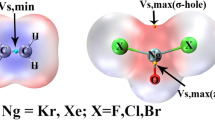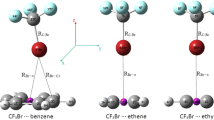Abstract
Several noble-gas-containing molecules XNgY were observed experimentally. However, the bonding in such systems is still not understood. Using natural bond orbital and natural resonance theory (NBO/NRT) methods, the present work investigated bonding of the title molecules. The results show that each of the studied XNgY molecules should be better described as a resonance hybrid of ω-bonding and \( \widehat{\sigma} \)-type long-bonding structures: X:− Ng+ − Y, X − Ng+: Y−, and X^Y. The ω-bonding and long-bonding make competing contributions to the composite resonance hybrid due to the accurately preserved bond order conservation principle. We find that the resonance bonding is highly tunable for these noble-gas-containing molecules due to its dependence on the nature of the halogen X or the central noble-gas atoms Ng. When the molecule XNgY consists of a relatively lighter Ng atom, a relatively low-electronegative X atom, and the CN fragment rather than NC, the long-bonding structure X^Y tends to be highlighted. In contrast, the heavy Ng atom and high-electronegative X atom will enhance the ω-bonding structure. Overall, the present work provides electronic principles and chemical insights that help understand the bonding in these XNgY species.





Similar content being viewed by others
References
Bartlett N (1962) Synthesis of chemical compound Xe+[PtF6]−. Proc Chem Soc 112:218–218
Hoppe R, Dähne W, Mattauch H, Rödder KM (1962) Fluorierung von xenon. Angew Chem 74:903
Christe KO (2001) A renaissance in noble gas chemistry. Angew Chem Int Ed 40(8):1419–1421
Lehmann JF, Mercier HPA, Schrobilgen GJ (2002) The chemistry of krypton. Coord Chem Rev 233:1–39
Pointner BE, Suontamo RJ, Schrobilgen GJ (2006) Syntheses and X-ray crystal structures of α- and β-[XeO2F][SbF6], [XeO2F][AsF6], [FO2XeFXeO2F][AsF6], and [XeF5][SbF6]·XeOF4 and computational studies of the XeO2F+ and FO2XeFXeO2F+ cations and related species. Inorg Chem 45(4):1517–1534
Grochala W (2007) Atypical compounds of gases, which have been called ‘noble’. Chem Soc Rev 36:1632–1655
Grochala W, Khriachtchev L, Räsänen M (2011) Physics and chemistry at low temperatures. Pan Stanford, Singapore, p 419
Zhang G, Fu L, Li H, Fan X, Chen D (2017) Insight into the bonding mechanism and the bonding covalency in noble gas–noble metal halides: an NBO/NRT investigation. J Phys Chem A 121(27):5183–5189
Pettersson M, Lundell J, Räsänen M (1995) Neutral rare-gas containing charge-transfer molecules in solid matrices. I. HXeCl, HXeBr, HXeI, and HKrCl in Kr and Xe. J Chem Phys 102:6423–6431
Pettersson M, Lundell J, Khriachtchev L, Räsänen M (1998) Neutral rare-gas containing charge-transfer molecules in solid matrices. III. HXeCN, HXeNC, and HKrCN in Kr and Xe. J Chem Phys 109:618–625
Khriachtchev L, Pettersson M, Runeberg N, Lundell J, Räsänen M (2000) A stable argon compound. Nature 406:874–876
Lundell J, Chaban GM, Gerber RB (2000) Combined ab initio and anharmonic vibrational spectroscopy calculations for rare gas containing fluorohydrides, HRgF. Chem Phys Lett 331:308–316
Lundell J, Khriachtchev L, Pettersson M, Räsänen M (2000) Formation and characterization of neutral krypton and xenon hydrides in low-temperature matrices. J Low Temp Phys 26:680–690
Khriachtchev L, Pettersson M, Lignell A, Räsänen M (2001) A more stable configuration of HArF in solid argon. J Am Chem Soc 123(35):8610–8611
Pettersson M, Khriachtchev L, Lignell A, Räsänen M, Bihary Z, Gerber RB (2002) HKrF in solid krypton. J Chem Phys 116:2508–2515
Khriachtchev L, Tanskanen H, Lundell J, Pettersson M, Kiljunen H, Räsänen M (2003) Fluorine-free organoxenon chemistry: HXeCCH, HXeCC, and HXeCCXeH. J Am Chem Soc 125(16):4696–4697
Feldman VI, Sukhov FF, Orlov AY, Tyulpina IV (2003) Experimental evidence for the formation of HXeCCH: the first hydrocarbon with an inserted rare-gas atom. J Am Chem Soc 125(16):4698–4699
Khriachtchev L, Tanskanen H, Cohen A, Gerber RB, Lundell J, Pettersson M, Kiljunen H, Räsänen M (2003) A gate to organokrypton chemistry: HKrCCH. J Am Chem Soc 125(23):6876–6877
Gerber RB (2004) Formation of novel rare-gas molecules in low-temperature matrices. Annu Rev Phys Chem 55:55–78
Berski S, Silvi B, Lundell J, Noury S, Latajka Z (2001) The nature of binding in HRgY compounds (Rg = Ar, Kr, Xe; Y = F, Cl) based on the topological analysis of the electron localisation function (ELF). In: Maruani J et al (eds) New trends in quantum chemistry and physics. Kluwer, Dordrecht, pp 259–279
Tanskanen H, Khriachtchev L, Lundell J, Kiljunen H, Räsänen M (2003) Chemical compounds formed from diacetylene and rare-gas atoms: HKrC4H and HXeC4H. J Am Chem Soc 125(52):16361–16366
Lein M, Frunzke J, Frenking G (2004) Christian Klixbull Jørgensen and the nature of the chemical bond in HArF // optical spectra and chemical bonding in inorganic compounds, vol 106. Springer, Berlin, pp 181–191
Alabugin IV, Manoharan M, Weinhold F (2004) Blue-shifted and red-shifted hydrogen bonds in hypervalent rare-gas FRg−H···Y sandwiches. J Phys Chem A 108(21):4720–4730
Khriachtchev L, Räsänen M, Gerber RB (2009) Noble-gas hydrides: new chemistry at low temperatures. Acc Chem Res 42(1):183–191
Pérez-Peralta N, Juárez R, Cerpa E, Bickelhaupt FM, Merino G (2009) Bonding of xenon hydrides. J Phys Chem A 113(35):9700–9706
Khriachtchev L, Domanskaya A, Lundell J, Akimov A, Räsänen M, Misochko E (2010) Matrix-isolation and ab initio study of HNgCCF and HCCNgF molecules (Ng = Ar, Kr, and Xe). J Phys Chem A 114(12):4181–4187
Juarez R, Zavala-Oseguera C, Jimenez-Halla JOC, Bickelhaupt FM, Merino G (2011) Radon hydrides: structure and bonding. Phys Chem Chem Phys 13:2222–2227
Wu HQ, Zhong RL, Kan YH, Sun SL, Zhang M, Xu HL, Su ZM (2013) After the electronic field: structure, bonding, and the first hyperpolarizability of HArF. J Comput Chem 34(11):952–957
Zhang G, Li H, Weinhold F, Chen D (2016) 3c/4e \( \widehat{\sigma} \)-type long-bonding competes with ω-bonding in noble-gas hydrides HNgY (Ng = He, Ne, Ar, Kr, Xe, Rn; Y = F, Cl, Br, I): a NBO/NRT perspective. Phys Chem Chem Phys 18:8015–8026
Zhang G, Zhang S, Chen D (2017) Long-bonding in HNgCN/NC (Ng = Noble Gas) molecules: an NBO/NRT investigation. J Phys Chem A 121(29):5524–5532
Zhang G, Song J, Fu L, Tang K, Su Y, Chen D (2018) Understanding and modulating high-energy property of noble-gas hydrides from their long-bonding: an NBO/NRT investigation on HNgCO+/CS+/OSi+ and HNgCN/NC (Ng = He, Ar, Kr, Xe, Rn) molecules. Phys Chem Chem Phys 20:10231–10239
Duarte L, Khriachtchev L (2017) An aromatic noble-gas hydride: C6H5CCXeH. Sci Rep 7:3130
Landis CR, Weinhold F (2013) 3c/4e \( \widehat{\sigma} \)-type long-bonding: a novel transitional motif toward the metallic delocalization limit. Inorg Chem 52(9):5154–5166
Glendening ED, Badenhoop JK, Reed AE, Carpenter JE, Bohmann JA, Morales CM, Weinhold F (2001) NBO 5.0. Theoretical Chemistry Institute, University of Wisconsin, Madison
Weinhold F (2012) Natural bond orbital analysis: a critical overview of relationships to alternative bonding perspectives. J Comput Chem 33(30):2363–2379
Glendening ED, Badenhoop JK, Reed AE, Carpenter JE, Bohmann JA, Morales CM, Landis CR, Weinhold F (2013) NBO 6.0. Theoretical Chemistry Institute, University of Wisconsin, Madison http://nbo6.chem.wisc.edu/
Weinhold F (2013) NBOPro 6.0. Theoretical Chemistry Institute, University of Wisconsin, Madison http://nbo6.chem.wisc.edu/nbopro_adv.htm
Weinhold F, Landis CR, Glendening ED (2016) What is NBO analysis and how is it useful? Int Rev Phys Chem 35(3):399–440
Glendening ED, Weinhold F (1998) Natural resonance theory: I. General formalism. J Comput Chem 19(6):593–609
Glendening ED, Weinhold F (1998) Natural resonance theory: II. Natural bond order and valency. J Comput Chem 19(6):610–627
Glendening ED, Badenhoop JK, Weinhold F (1998) Natural resonance theory: III. Chemical applications. J Comput Chem 19(6):628–646
Arppe T, Khriachtchev L, Lignell A, Domanskaya AV, Räsänen M (2012) Halogenated xenon cyanides ClXeCN, ClXeNC, and BrXeCN. Inorg Chem 51(7):4398–4402
Zhu C, Räsänen M, Khriachtchev L (2015) Fluorinated noble-gas cyanides FKrCN, FXeCN, and FXeNC. J Chem Phys 143(7):074306
Frisch JA, Trucks MJ, Schlegel GW, Scuseria HB, Robb GE, Cheeseman MA, Montgomery Jr JA, Vreven T, Kudin KN, Burant JC, Millam JM, Iyengar SS, Tomasi J, Barone V, Mennucci B, Cossi M, Scalmani G (2009) Gaussian 09, revision B.01. Gaussian, Inc., Wallingford
Purvis GD, Bartlett RJ (1982) A full coupled-cluster singles and doubles model: the inclusion of disconnected triples. J Chem Phys 76(4):1910–1918
Raghavachari K, Trucks GW, Pople JA, Head-Gordon M (1989) A fifth-order perturbation comparison of electron correlation theories. Chem Phys Lett 157(6):479–483
Lee C, Yang W, Parr RG (1988) Development of the Colle-Salvetti correlation-energy formula into a functional of the electron density. Phys Rev B: Condens Matter Mater Phys 37(2):785
Becke AD (1993). J Chem Phys 98:5648–5652
Feller D (1996) The role of databases in support of computational chemistry calculations. J Comput Chem 17(13):1571–1586
Dunning TH (1989) Gaussian basis sets for use in correlated molecular calculations. I. The atoms boron through neon and hydrogen. J Chem Phys 90(2):1007–1023
Foresman JB, Frisch E (1996) Exploring chemistry with electronic structure methods. Gaussian, Inc., Pittsburgh
Rappoport D, Furche F (2010) Property-optimized Gaussian basis sets for molecular response calculations. J Chem Phys 133(13):134105
Werner HJ, Knowles PJ, Manby FR, Schutz M et al (2010) MOLPRO, version 2010.1, a package of ab initio programs, see http://www.molpro.net
Zhang G, Yue H, Weinhold F, Wang H, Li H, Chen D (2015) Resonance character of copper/silver/gold bonding in small molecule···M–X (X=F, Cl, Br, CH3, CF3) complexes. ChemPhysChem 16(11):2424–2431
Zhang G, Wang H, Yue H, Li H, Zhang S, Fu L (2015) Ligand effects due to resonance character in LAuCCH− (L=F, Cl, Br, I, CCH) complexes: an NBO/NRT analysis. J Mol Model 21:159
Politzer P, Murray J, Clark T (2015) Mathematical modeling and physical reality in noncovalent interactions. J Mol Model 21:52
Acknowledgments
This work was supported by the Natural Science Foundation of Shandong Province (No. ZR2015BM025). We thank Professor Frank Weinhold of the University of Wisconsin-Madison for his continuous help.
Author information
Authors and Affiliations
Corresponding author
Electronic supplementary material
ESM 1
(DOC 34.4 kb)
Rights and permissions
About this article
Cite this article
Song, J., Su, Y., Jia, Y. et al. Resonance bonding in XNgY (X = F, Cl, Br, I; Ng = Kr or Xe; Y = CN or NC) molecules: an NBO/NRT investigation. J Mol Model 24, 129 (2018). https://doi.org/10.1007/s00894-018-3665-0
Received:
Accepted:
Published:
DOI: https://doi.org/10.1007/s00894-018-3665-0




